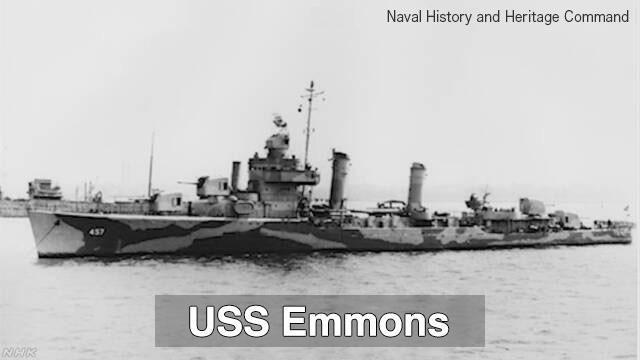Sunk by suicide attack
A warship lies on the seafloor, about 40 meters underwater, near Kouri, a small island off the northern part of Okinawa Island.
It's the USS Emmons, a destroyer minesweeper about 106 meters long. It's so big you can't see the whole thing, even in the clear Okinawa waters.

An over 5-meter-long cannon sticks out of the vessel. 4 torpedoes were left unexploded on its stern. According to a US military report, the Emmons sank after suffering 5 kamikaze attacks. More than 60 crew members were killed or went missing.
In April 1945, over 1,300 American naval ships closed in on Okinawa. The Japanese military made a desperate counteroffensive, using more than 1,800 aircrafts in a kamikaze suicide mission. A number of ships are believed to have been sunken in the battle, but only a few can be found under the sea today. The Emmons is one of them.
Where did the ships go?
During the 1950s, there was an iron rush in Okinawa. Demand from the Korean War pushed up prices of scrap iron and steel and American warships were salvaged and dismantled, with the pieces being sold to Japan's main islands. The remains from one war were recycled and reused in another war. Ships were raised from the seafloor and scrapped until about 1957.

Takemitsu Shinzato is a fisherman on Tokashiki Island. He remembers watching as an 8-year-old boy the dismantling of an American vessel sunken by kamikaze attacks.
"A big barge came to the island and blew up the warship, which was almost 80 meters long. They took the debris and left in a blink of an eye," he said. "I remember thinking people would take anything for money, to make a living."
NHK dove and filmed near where Shinzato said the ship once was. Remains of the vessel came into sight near the seafloor. It was hard to imagine these parts were once a massive warship.
The coral that had grown on deck boards was evidence of time passed. Wires appeared to have torn off and artillery shells were scattered around. The wreckage looked bizarre amid the clear blue water, with fish swimming leisurely around.
A deteriorating time capsule
Chiaki Katagiri, chief research specialist of the Okinawa Prefectural Buried Cultural Property Center, describes these relics as "time capsules." He says that undocumented marks of damage are found intact in the wreckage. But exposed to seawater for decades, the ships are deteriorating and breaking down. Katagiri says establishing a method to preserve and make use of the undersea battle sites is an urgent task.
Maintain the sites with technology

Work to maintain the sites using cutting-edge technology is starting, and the USS Emmons has been chosen as the target of the experiment. Professor Hironobu Kan of Kyushu University's Research Center for Coastal Seafloor has been working with archeologists in Okinawa for 6 months to create a 3D image of the Emmons by using 1,800 pictures.
Researchers are now able to look inside the ship just by enlarging the 3D image or changing an angle. They no longer have to actually dive underwater.

The technology has led to a new discovery. It was confirmed that the ship's bridge and stern were severely damaged by kamikaze attacks, with fragments scattering far and wide. There was no sign that these fragments had drifted with waves, indicating that the explosions caused by kamikaze attacks were much more powerful than previously thought.
The researchers also learned more about the extent of the ship's deterioration. The 3D imagery revealed that the vessel's body was bent on a rock reef on the seafloor. The researchers fear the ship might break into pieces if nothing is done.
Let the battle site tell its history

The 3D image is being used not only for research, but as educational material. In a history class at Kyushu University, students were shown an image of the damaged Emmons. The destruction caused by the kamikaze attacks could not be observed in detail before.
In the class, Professor Kan told students that since people with experiences of the war are aging, it is up to young people to keep the memories of the tragic past alive, by maintaining relics and documents.
The deteriorating remnants of war lying at the bottom of the sea serve as a reminder that we cannot let history and memories, no matter how tragic, fade away.
